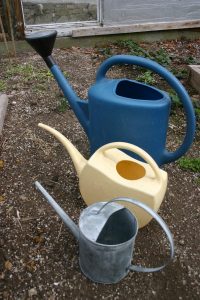My watering can sprang a leak and I went online to find the best one for watering greenhouse plants. Frankly, from what I found, very few cans were worth spending a lot of money on. Most were cheap plastic cans that will spring a leak if you try to use them more than twice. (Then you can use them as a planter!) Many of them had fixed downward facing spouts. All that does is dump water on the plants as fast as possible. Many did not even have a sprinkler on the end. That means you can only water the soil in a pot and not have the option of giving a plant a sprinkle in hot weather.

The one-gallon yellow can is generally kept in the upstairs bathroom. It fits under the hot water spigot and when I draw hot water from the basement hot water heater, it takes about ½ to ¾ of a gallon of water before hot water reaches the spigot. This can is also handy for watering under plants where the leaves must be kept dry.
The galvanized metal can is somewhat indestructible – until it rusts. The handle was somewhat flimsy and eventually broke long before the can rusted.
What do I consider to be a good watering can? First, it needs to be able to carry up to three gallons of water. With more than 200 plants in the greenhouse, I don’t want to make twenty-three trips to the rain barrel just to water plants.
Second, it needs to have a removable, adjustable sprinkler that can be turned up or down, depending whether I want to pour a gentle rain (upward turned sprinkler) or dump a lot of water (okay for orchid bark), or water the plant without getting the leaves wet (remove the sprinkler and pour gently.)
A smaller (one gallon or even half-gallon) watering can with no sprinkler is ideal for watering plants such as African Violet where you do not want to get the plant crown or leaves wet. With a small spout you can apply just the right amount of water away from the leaves.
A plastic can is fine as long as it is heavy enough to take a pounding when it has to dip it down into the rain barrel. Yes, I have a spigot on the rain barrel, but when the water level is low, the spigot doesn’t always work. Sometimes the spigot gets blocked, and I have to tip up the barrel to get water out or clear the blockage. If I tip the rain barrel, it tends to lean on top of the watering can as I try to get every last drop of water. That may crush the watering can a little, so it probably should be somewhat flexible.
A good watering can also needs two handles (or one that goes from the spout to the bottom rear of the can), with two handles, one on top and one at the back, you can tip the can and steady it with the other hand. It is almost impossible to tip the can and get a constant flow of water with only a top handle.
The other thing a watering can needs is lack of weight. Metal cans tend to be heavier than plastic cans. If you use a three-gallon can, the weight of water is around 24 lbs. Add the weight of the can (three to seven lbs) and you may have to tote 27 to 30 pounds around when watering your plants.
You may think that any old can will do but having the right watering can save a lot of walking and can water your plants precisely without damaging them – unless you drop the watering can on them!










